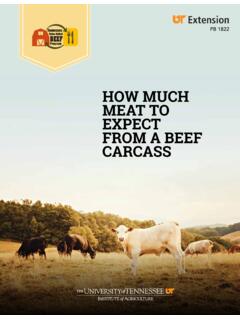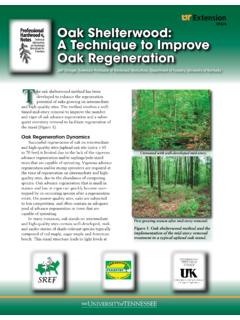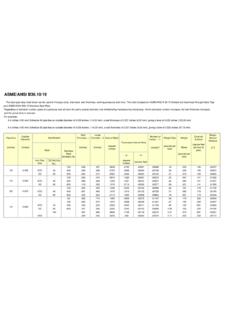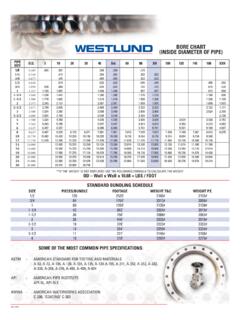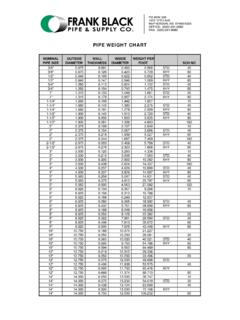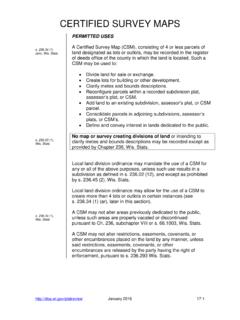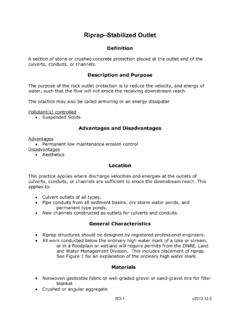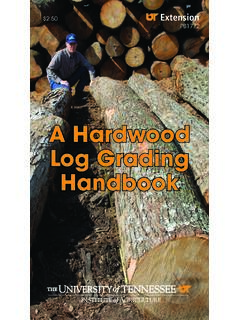Transcription of Estimating Weight of Logs and Standing Timber
1 By David Mercker, Extension Specialist II, Department of Forestry, Wildlife and FisheriesAdam Taylor, Associate Professor, Department of Forestry, Wildlife and FisheriesSP 748 IntroductionStanding Timber , logs and lumber are often bought and sold by the board foot . A board foot is a volume measurement (144 cubic inches) equal to a board that is 1-inch thick, 12 inches long and 12 inches wide. The board footage of logs is an estimate of the amount of lum-ber that will be sawn from them. Many different techniques, or scales, have been developed to make these estimates, based on three measurements: Length Measured in feet with a few extra inches of trim (4-8 inches). Diameter The scaling diameter is measured as the wood diameter ( , inside the bark) at the small end of the log. Logs are usually not perfectly round, so the average of two measurements is often used. Diameter at breast height (dbh) is the outside-the-bark diameter of a Standing tree measured at feet above ground level (on the uphill side of the tree on sloping ground).
2 Deductions for scaling defects Reducing the amount of lumber that can be produced, including excessive sweep or rot. Once the log has been scaled, the board footage is multiplied by the price per board foot to determine the value of the log. The price per board foot is a function of many variables, including the wood species, the grade of the log ( , the estimated lumber quality), the local market conditions, log size and more. The gen-eral approach to determine log value also can be applied to stand-ing trees. Refer to PB 1772 A Hardwood Log Grading Handbook (Taylor 2009) for more detailed explanations of log in the Timber industry have switched from board foot measurement to Weight measurement (specifically tons) for delivered logs. Within this system, trucks carrying logs arrive at the mill and then are weighed, unloaded and re-weighed. Loggers are paid based on the Weight of the delivered logs. Many forest-ers and landowners are uncertain of how wood Weight (tons) is measured, how to convert board feet estimates to tons, or how to arrive at the value of Standing Timber and logs when the board foot measurement is known but the Weight is not.
3 This publica-tion has been developed to address these questions and does so for both hardwood and pine species. Readers should note that there is great variability in the estimation of wood volume and Weight of Standing Timber and Footage and WeightFor traditional board foot measurements, simple tools have been developed for field estimations. Logs can be scaled quickly by measuring the small-end diameter with special sticks that are calibrated for particular log scales. Board footage estimates for Standing trees can be performed using a Biltmore stick, diameter tape, clinometer and hypsometer. The diameter at breast height (dbh) and the number of logs and their lengths are used in volume tables to estimate the board foot volume of Standing equations have been developed for predicting log weights from species, diameter and length information (Table 1). Using these equations, data tables listing the Weight of logs for given diameters and lengths can be derived. Here, we show results for average values for red and white oaks, hickory, and yellow poplar (Table 2) and for mixed Southern pines (Table 3).
4 Log Weight also can be estimated indirectly by converting a board foot measurement to tons. The Weight of logs and the conversion of board foot to tons are subject to much uncertainty because many variables can affect the Weight of logs and the accuracy of board foot scales (Table 4). Estimating Weight of Logs and Standing Timber Guide for Foresters, the Forest Industry and LandownersTable 1. Equations for predicting log Weight based on length and diameter. SpeciesWeight prediction equation Standard error of the prediction (pounds)Red oaks (Quercus spp.)W = - + oaks (Quercus spp.)W = - + (Carya spp.)W = - + poplar(Liriodendron tulipifera)W = - + yellow pine(Pinus spp.)W = + : W is log Weight in pounds; D is small-end diameter, inside the bark, in inches; L is length in feet without trim. Equations for hardwoods are from Timson (1972); pine equation is from Siegel and Row (1960).Conversion Factors LogsAs introduced above, there is considerable variability in volume-to-ton conversion, especially among hardwood species.
5 Log diameter has a particularly large influence, because log rules often underestimate lumber yields from small logs. For example, 1,000 Table 2. Log Weight table and MBF conversion factors for mixed hardwoods. Scaling Diameter (inches)Average Hardwood Log Weights (tons)Tons per MBF Doyle--- Log length (feet) 11 adapted from Timson (1972) for white and red oaks, yellow poplar and hickory sampled in West Virginia, Virginia and Maryland. Scaling diameter is the average diameter inside the bark at the small end of the log; MBF is 1,000 board feet. Tons per MBF value is an average over all log feet of Doyle scaled logs can weigh, on average, from 15 to 5 tons for log (scaling) diameters from 8 to 20 inches, respec-tively (Table 3). However, even for logs of the same diameter, weights for individual logs can range plus or minus 40 percent of the average 3. Log Weight table and MBF conversion factors for Southern pine.
6 Scaling Diameter (inches)Average Pine Log Weights (tons)Tons per MBFD oyle --- Log length (feet) adapted from Siegel and Row (1960) for mixed loblolly and shortleaf pines sampled in Louisiana and Arkansas. Scaling diameter is the average diameter inside the bark at the small end of the log; MBF is 1,000 board feet. Tons per MBF value is an average over all log 4. Variables affecting log Weight and scale measurements. VariableEffectDiameterBoard foot scaling rules tend to underestimate the lumber yield from small logs. This is especially true of the Doyle rule, in which this over-run (the difference between the actual and estimated yield) can be over 100 percent for small of the log in the treeWood density can increase further up the tree, meaning upper logs weigh more per board foot ; conversely, there can be more taper in butt logs, and tapered logs will weigh more for a given footage, because foot -age is estimated using the small end after fellingLogs lose moisture and thus Weight once harvested, especially during hot and dry tree species produce wood with different density and moisture content.
7 These both affect log Weight . However, denser wood species often contain less water, so log weights don t vary as much by species as do dry lumber Weight can differ depending on site characteristics and of the yearLogs may weigh slightly more in the spring and slightly less in the sum-mer than in the rest of the year. This is likely due to changes in the water content of the rateDepending on the species, increased growth rates may be associated with lower, higher or unchanged log Factors Standing TimberAs described above, the conversion of log volumes to Weight varies with log diameter. For convenience, mills commonly settle on a fixed conversion factor when procuring logs (for example, from 8-9 tons/mbf for hardwood and from 7-8 tons/mbf for pine). However, as Tables 2, 3 and 5 illustrate, using a fixed conversion factor requires making an accurate assumption about average log or tree diameter. Table 5. Relationship of diameter at breast height (DBH) measurements to tons/mbf (Doyle) conversion factors.
8 DBH(inches)Log Weights tons/mbf (Doyle)Mixed hardwoods1 Southern pine from Dicke and Parker (2010) and Doruska et al. (2006)1 oaks, hickory, sweetgum Converting Tonnage Price to Board foot PriceIn some cases, log prices are reported as the price/ton deliv-ered to the mill. In other cases, prices are given on a board foot basis. Thus, field practitioners and landowners may be interested in converting the delivered price/ton to a price/bf. The conversion process is simple but requires assuming a ton-to-mbf conversion factor. If a hardwood conversion of 9 tons/mbf (Doyle) is assumed, then each ton has 111 board feet (1,000 board feet 9 tons/mbf = 111 bf):Therefore, a delivered sawlog price of $40/ton is equal to $40/111 bf, or 36 cents/board foot ($360/mbf). Similarly, $50/ton = 45 cents/board foot = $450/mbf$60/ton = 54 cents /board foot = $540/mbfNotes As explained above, the conversion of board foot measurements to Weight is subject to much uncertainty. Thus, the conversion factors listed here and the calcula-tions derived from them should be used only for general guidance.
9 To arrive at stumpage value (the value of the Standing Timber ), the costs of logging and hauling are subtracted from the delivered , S. and R. Parker. 2010. Pine Timber volume-to- Weight conversions. Mississippi State University Extension Service. Publication 2244. ( ). Doruska, P., D. Patterson, J. Hartley, and M. Hurd. 2006. Outside-bark green tons per thousand board feet: A case study using sawtimber-sized hardwood trees in Arkansas. Journal of Forestry 10(7):345-351. Siegel, and C. Row. 1960. Selling sawlogs by the ton. Forest Farmer 19(13):8-9. Taylor 2009. A hardwood log grading handbook. University of Tennessee, Knoxville, TN. Extension PB 1772. 28 pp. ( ). Timson, 1972. Sawlog weights for Appalachian hardwoods. Dep. Agric. For. Serc., Res. Pap. NE-222. 29 pp. E12-4911-00-004-13 11/12-1M 13-0087 Programs in agriculture and natural resources, 4-H youth development, family and consumer sciences, and resource development. University of Tennessee Institute of Agriculture, Department of Agriculture and county governments cooperating.
10 UT Extension provides equal opportunities in programs and

